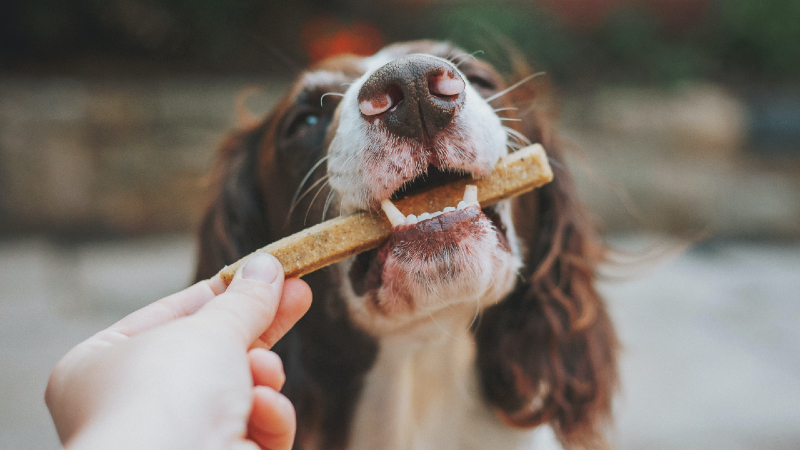
You might have heard the term “whale eyes in dogs” before, but what does it actually mean? The term is originally credited to Sue Sternberg, an expert in canine behavior, and it refers to when a dog shows the whites of the eyes, turning their head away from, but still looking at something or someone.
Whale eye is a sign of an anxious dog. They may be stressed out, frightened, or feeling threatened by someone or something in their vicinity. If a dog is giving you the “whale eye”, it’s vital that you recognise it, as they’re trying to tell you they’re uncomfortable or in distress. From there, you need to identify the cause of their discomfort and manage, or remove it, if possible — either by removing the threat, or removing your dog from the situation.
There are lots of potential causes of anxiety in dogs. Some dogs are stressed out by unfamiliar people or animals, while others hate loud noises, or even just being in new situations and locations. Separation anxiety in dogs is another big cause of stress for dogs that are left alone during the day.
Below you’ll find some tips on how to recognise “whale eye” in dogs, as well as advice on reducing stress and anxiety. We also have an in-depth guide on how to calm a dog during periods of high anxiety if you need further advice.
What is whale eye in dogs?
Whale eye in dogs has nothing to do with whales. Whale eye is when a dog shows the white part of his eyes, also known as the sclera. This occurs because the dog has turned his head away but has continued looking at the person or object in his path, showing the whites of his eyes. The eyes may also appear more round than usual and the pupils may be dilated.
Dogs display whale eye when they are tense, stressed, anxious, or frightened. The dog may also show other symptoms of anxiety or distress such as a stiff body posture, lip licking, yawning, low tail carriage, or a tense jaw.
The rather strange name is attributed to Sue Sternberg, a canine behavior & shelter dog specialist. We got in touch with Sue to ask her about the origin of the term "whale eye"
"It refers to the fact that whales don’t have a neck that moves, so if they want to look at something they move their eyes more than their heads/bodies, which shows the whites more" explained Sternberg.
Are whale eyes always a bad sign?
Whale eye is a sign that your dog is feeling anxious, stressed, or frightened. However, it's important to distinguish true whale eye from other reasons why you may see the whites of your dog's eyes.
To do this, you'll need to consider your dog's behavior in the context of his environment. If your dog simply looks at something without turning his head, but otherwise has relaxed body posture, this is not a whale eye even though you may see the whites of his eyes.
On the other hand, if your dog sees something threatening and turns his head away but keeps his eyes focused on the perceived threat, you will see the whites of his eyes as well as other anxiety-related behavior such as a stiff body posture. This is a true whale eye and is a sign that your dog is feeling threatened and uncomfortable.
What to do when dogs show whale eye

Dogs show whale eye in response to a perceived threat. This could be anything from an unfamiliar dog to a new object in their path or a person doing something scary that they don’t like.
If your dog is showing a whale eye, the first step is to identify the trigger – that is, the cause of your dog's distress. If you can identify the trigger, you can avoid or manage it to help your dog feel more comfortable in the situation.
Often the best way to do this is to remove your dog from the threatening situation entirely. For example, a dog that is anxious around other dogs may show whale eye in response to an unfamiliar dog approaching while on a walk.
The trigger in this case is the unfamiliar dog. You can help your dog feel more comfortable by giving your dog extra space away from this unfamiliar dog. Consider crossing the street or turning and walking in the opposite direction to avoid the trigger and reduce your dog's distress.
What other signs should I look out for?
Whale eyes might be the subject of today’s article, but there are lots of other signs of stress in dogs that you can pick up on, if you know what you’re looking for. We spoke to expert vet Rebecca MacMillan BVetMed and asked her for advice on what else to look out for.
“As a vet, I see a lot of anxious dogs coming through my doors, so I’m hypervigilant about their body language.” says MacMillan. “I find that many owners miss some of the more subtle cues of stress in their dogs”
Dr MacMillan lists some of the most common signs of stress that she picks up on in dogs that come to her vets. “Some of the early markers of stress that I regularly see include excessive panting, yawning, or licking of the lips. Many of these dogs will also have tense bodies too, they might be crouching, tucking their tail between their legs, or trembling. Some dogs are even more subtle than this and could be just leaning away, raising a paw, or rolling over.”
Dogs tend to escalate these behaviors as their stress levels increase, a phenomena known as the “‘ladder of communication” or “ladder of aggression”. They will begin with subtle signs like those noted above, but if they remain in that uncomfortable situation for longer periods of time, or if it gets even more stressful, their symptoms may escalate to include “becoming restless, growling, raising their lips, or even snapping/biting.”
If you’re not confident that you can properly identify some or all of these behaviors in your dog, or you’re just looking for reassurance, check out our guide to dog body language for a refresher on how to read the signals that your dog is sending you.
Finally, MacMillan notes that “Any stressed dog has the potential to bite so warning signs should be taken seriously.”
Final thoughts
If your dog is showing a whale eye, this is a sign to take notice of your dog and his environment. Your dog is signaling that he feels threatened by something, so you’ll need to identify the trigger quickly and remove your dog from the situation to alleviate his distress.
Whale eye is an important sign of fear and anxiety in dogs, especially when accompanied by other signals such as a stiff body posture, lip licking, yawning, raising a paw, tense jaw, or other signs of discomfort. Knowing how to read these canine body language signs is essential to maintain good communication with your dog.







